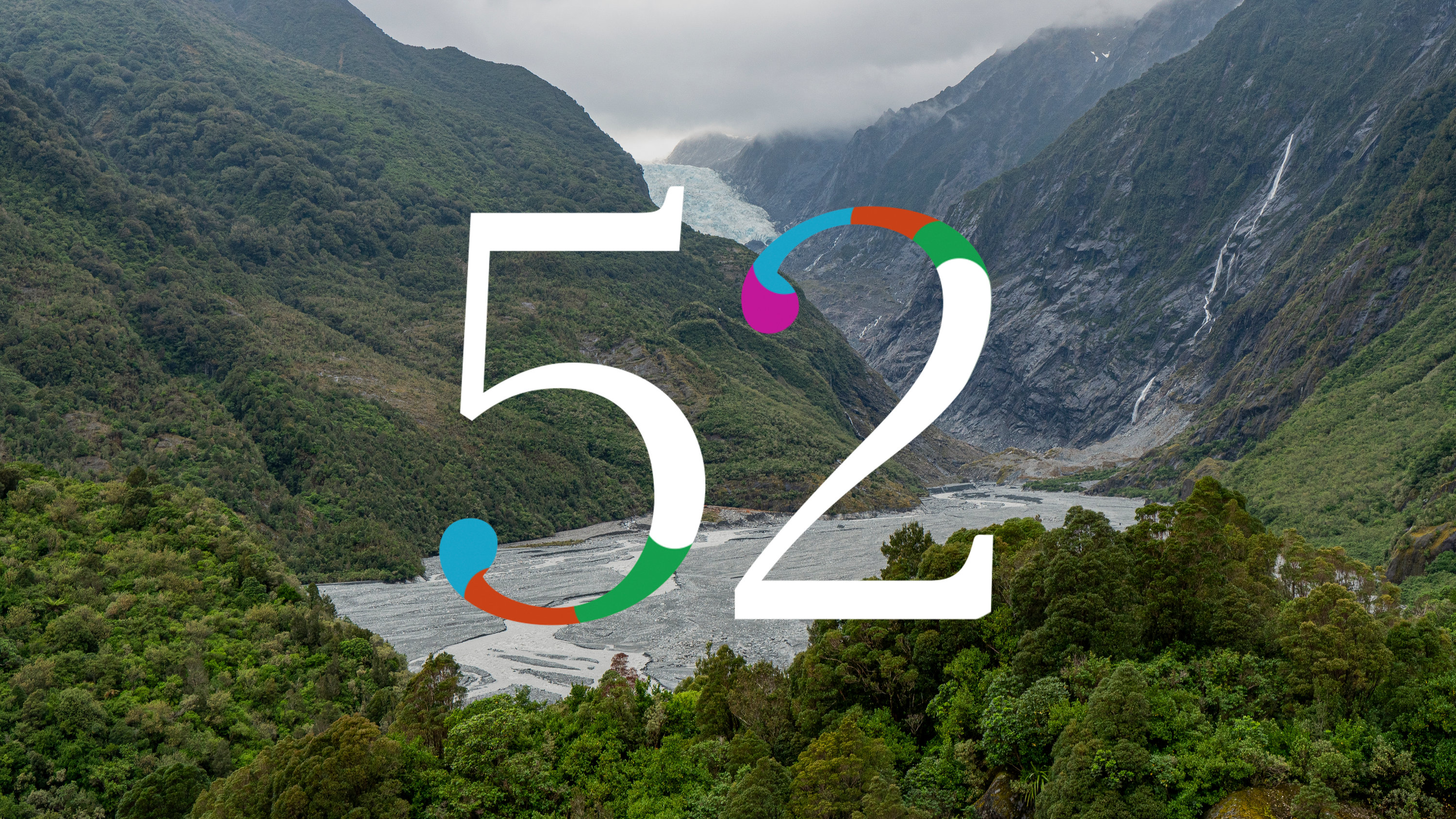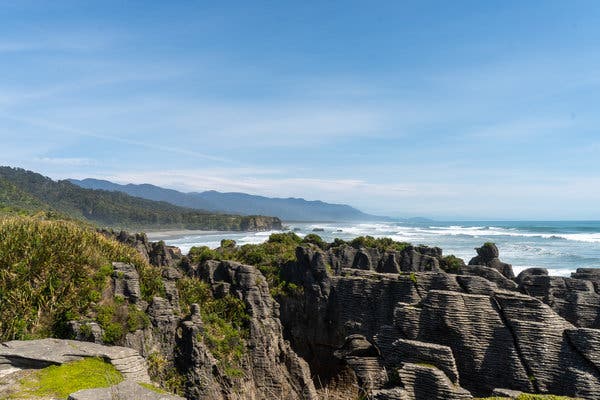The 52 Places Traveler
For Stop #47, the 52 Places Traveler reveled in nature unleashed on the new Paparoa Track, where alpine forests and craggy peaks give way to dense rainforest.
transcript
Trekking Through New Zealand’s South Island
Produced by Meg Felling and Sebastian Modak
-
[MUSIC PLAYING] I’m not even halfway to my destination. I’ve been driving for, like, three hours. Holy … Ooh, where to begin? New Zealand was just one “wow” after another. I don’t think there’s been a place as physically and naturally stunning that I’ve been this year. This country is incredible. I started from Christchurch, basically cutting across the whole South Island, east to west. I’ve been out of Christchurch for all of 20 minutes and I’ve already stopped, like, four times. This is going to be a long drive. Google Maps said it would take about three and a half hours. Turns out that that actually means seven hours in New Zealand. Not because of traffic, but because it’s just so stunning. Yup. As predicted, another stop. This time to see this. I was pulling over every other mile to take it in and breathe in the fresh air. Can’t not stop. Just amazing, beautiful. Eventually, I made it to Punakaiki. It’s famous for these pancake rocks, so named because they look like stacks of pancakes. Those rock formations are just incredible. It’s like we’ve reached the end of the world. So close to the end of my trip around the world, I reached the end of the world. And then, the next day was really the main event. The Paparoa Track, which is a new hiking trail that was opening literally days after I arrived in New Zealand. I was able to get a little preview of it. It was very cool to see it before anyone else did. I was told, hey, you’re probably the first American to walk this track, which is kind of a cool feeling. I don’t know what I expected. I think it’s because of “Lord of the Rings,” I was expecting more kind of alpine terrain, but it was very jungle-y. It’s like the flora has been frozen in time. These huge ferns and giant towering palms, and, you know, you half expected a velociraptor to jump out at you. It feels like I’ve gone back to prehistoric times. It’s stunning. And then one of the days I saw like a trail head by the beach. Wow. So I got to the top and there’s this little landing that you look to your left and you see the beach, and then to the right, I can just make out Mount Cook and, you know, these other towering, snow-capped mountains. I really was just so humbled by nature on this stop. The way you have all these little micro-ecosystems — glaciers, and beaches, and jungles, and lakes, and rivers. And it could feel like Switzerland, Hawaii, the Azores and the Amazon, all in a single day. And that’s what’s so remarkable about the South Island of New Zealand. There have been a few places on the stop that had just been about beauty, natural beauty. What we have left on this earth despite losing so much. There’s still places left that are pristine. The more people see them, the more we can realize what’s left and what there is to protect. And I think New Zealand does a great job of putting that on display. [MUSIC PLAYING]

There is a bird in New Zealand that sounds exactly like R2D2. Among the competing chirps and trills of the rainforest, the bleeps and bloops of the tui, a small dark bird with the white collar of a priest, interrupted with perfect comedic timing. I found it impossible not to smile every time I heard it — and over the course of a week in New Zealand’s West Coast region, I heard it often. Soon, it started feeling like a familiar friend. On long solo hikes, soaked through with rain, calves burning, I heard the tui, beckoning me around the next bend where some new sight would undoubtedly leave me breathless.
When I arrived on the West Coast, a 370-mile strip of land on New Zealand’s South Island, there was an omnipresent buzz about a new opening. Nearing the end of my trip around the world, I’m familiar with this brand of excitement by now: I felt it in Doha days before the opening of the Qatar National Museum, and in Dessau for the Bauhaus Museum. This time, it wasn’t a museum that people were excited about but a new hiking trail.

The Paparoa Track is the tenth of the New Zealand Great Walks, multi-day treks overseen by the Department of Conservation that cut through protected mountains, forests and valleys. In all it is 34 miles long and can be completed in three days by foot or two on a mountain bike. Three huts are placed at intervals along the trail, which cuts through Paparoa National Park, passing river gorges, up onto mountain ridges that overlook the sea and through dense primeval rainforests. So intense is the excitement around its opening that the huts are mostly booked solid through March.
While the Paparoa Track is the first new Great Walk in 25 years, it’s not as if the South Island is lacking in natural grandeur. On my drive to the West Coast, I could barely get through a single song on the “Lord of the Rings” soundtrack (I mean, what else would I be listening to?) without hitting another viewpoint so beautiful I had to stop. Google Maps says that the drive from Christchurch across the island to Greymouth should take about three hours. It took me seven.
The beauty began almost immediately outside Christchurch as the wide open pastures revealed the snow-capped peaks of the Southern Alps. In the blinding light of a clear noon sky, they seemed to sparkle. The road began to curve as I reached the mountain range’s foothills, where towering rock formations hinted at what was to come. I hit Arthur’s Pass, a former gold rush outpost surrounded by beech forests and thundering waterfalls. I kept driving. Water that looked like spilled cyan paint rushed along river beds made from smooth, multicolored stones; mist clung to dew-sprinkled forests that grew down steep inclines; with the exception of the two-lane road and the power lines that ran along it, the terrain seemed entirely untouched by civilization.
Eventually, I reached Greymouth, my base to explore the Paparoa Track and the greater West Coast region. Greymouth, known to the Maori long before Europeans arrived as Mawhera, has seen better days. Once a hub for coal and gold mining, today it feels like a time warp to the 1970s, when the boom started to run out. The regal facades of once grand hotels are peeling, their innards carved out and abandoned. The streets are empty — by 8 p.m. it was as if I were the town’s only resident.
From Greymouth it was a short drive up the stunning Great Coast Road to Punakaiki, where I came across the only tour buses I saw in a week. The crowds — myself included — were there to see the Pancake Rocks, 30-million-year-old limestone formations that look like stacks of flapjacks, jutting out of the turbulent sea and creating pockets of air that send ocean spray shooting into the sky.
When I arrived, the Paparoa Track was still days from opening. But I was able to get a sneak preview of it, meaning I covered about six miles — or 17 percent — of the whole journey. After traveling through a landscape dominated by alpine forests and craggy peaks, it was jarring to head into the dense rainforest of Paparoa National Park. I couldn’t make sense of the terrain’s quick transition. Prehistoric ferns the size of golf umbrellas stretched over the dirt and stone paths and smaller ferns stood coiled, ready to spring to life. Mushrooms grew on the roots of trees felled by passing storms. The path sloped upward until it offered views of the Pororari River far below.
Construction crews were putting the finishing touches on the track. Helicopters transported buckets of gravel to hard-to-reach switchbacks. Workers spoke about every curve and big tree as though they were in their home neighborhood. One explained that the path we were walking on was actually revamped, not brand new. It had been used by gold prospectors in the 19th century: history woven seamlessly into nature. The Paparoa Track intersects the Pike29 Memorial Track, dedicated to the 29 people who died in a methane explosion at the Pike River Mine in 2010.
If you go
-
Don’t expect luxury when it comes to accommodations. That’s not why you’re here. In fact, many tourists opt to rent camper vans and take advantage of New Zealand’s “freedom camping” laws that make it easy to find a place to park for the night. Just make sure you’re familiar with the rules around waste disposal and off-limits areas before you set off.
-
New businesses are springing up close to the Paparoa Track trailheads to cater to hikers and mountain bikers. I previewed one, the family-run Punakaiki Beach Camp, which is building new cabins and has a new shuttle to transport cyclists to and from the trail. Like the huts on the track itself, these places are filling up fast so be prepared to plan ahead.
-
While Greymouth isn’t the most inspiring home base for exploring the West Coast region (I wish I had opted for nearby Hokitika instead), it’s worth making a stop at Monteith’s, a large, airy brewery with excellent food and even better ales.
From Paparoa National Park I made my way south, following the Great Coast Road until it became the Glacier Highway and the terrain changed again, from the wet rainforests of the coast to steep mountains. I stopped in Hokitika, a far livelier town than Greymouth, famous for a gorge cut through with that same bright blue water I had been seeing everywhere, and for its jade-carving industry. Most of the shops selling New Zealand jade in town have open workshops, so I watched as carvers turned raw blocks of jade into twisting, glistening creations full of Maori symbolism.
Eventually, following the road south, I reached Franz Josef, a small town at the foot of a glacier of the same name. Dense clouds obscured the highest mountain peaks, but following a trail through the woods I walked until I came right to the glacier. Just under the shroud of gray, I could make out its tongue, thick ice blue with age. Since 2008, the glacier has retreated by about 2,600 feet, and rivulets of meltwater cutting through gray rock clearly show its once extensive reach.
The best way to see the glacier, I was told, was from the air. I booked a “snow landing” with one of the many companies offering helicopter rides over not only Franz Josef Glacier, but Fox Glacier farther down the island. Over the course of three days though, it became clear it wasn’t going to happen. The thick clouds and occasional rain meant the helicopters remained on the ground. (The dangers of adventure tourism were made clear just over a week after I left when the White Island volcano erupted, killing at least 16 people.)
I’m getting good at improvising so I looked for other diversions. In this part of the world, there are plenty. I hiked around Lake Matheson, where the still water serves as the perfect mirror for the tall trees and towering mountains that hover over it. I picked hiking trails arbitrarily — there was no way I was ever going to hit them all. On one, the Okarito Trig walk, I climbed a gradual incline until I reached a lookout point. To my left was the sea, partially obscured in evaporating mist; in front of me were thick forests, a falcon swooping just above the canopy; and to my right, I could just make out the Southern Alps. Over the course of 20 minutes, while I stood hypnotized by birdsong, the sun came out and burned away the clouds, revealing the full panorama of mountains.
I decided to change things up for my return trip to Christchurch and take the five-hour TranzAlpine train back to Christchurch, widely considered to be one of the most scenic train trips in the world. Tall windows ensure everyone has a view, and from an open-air viewing car in the back you can take photos without the glare of window panes.
Without having to focus on the road, I was able to really take in the scenery and an audio commentary provided context. I learned of the significance of this land to the Maori people and of the generations of colonial prospectors that showed up to mine it. We passed towns that were once thriving and now are reduced to one or two sheds, covered with weeds and rust. I learned that the average life expectancy of a horse working these mountain passes was just 18 months, and that the Southern Alps is one of the fastest rising mountain ranges in the world; if it weren’t for erosion, Mount Cook, the tallest of the mountains, would tower over Everest.
Watching the landscape pass by, like a flipbook of postcards, I realized what was so special about New Zealand. There’s the environment, of course; it can feel like you’ve traveled to Hawaii, Ireland, Norway and the Azores over the course of a single day. But it’s also how New Zealanders interact with their environment. Around 86 percent of land in the West Coast region is protected by the Department of Conservation. Most of the tourists I encountered were locals, out for weekend family trips to hike, camp and picnic. The Paparoa Track was finally opening after being funded by tax dollars and blessed by the local Maori population. This is a place that has been given a disproportionate serving of natural splendor and people here recognize its value. Honoring it is a national pastime.
By the time I reached Christchurch, I was rejuvenated. Despite the wear of daily hikes and inclement weather, I felt better rested than I have in a long time. Nature, unleashed like it is on the South Island of New Zealand, has the power to reset your entire being. Just a month from the finish line, it was like I was back at day one of this year of travel. And all it took was a little fresh air.







